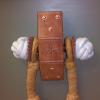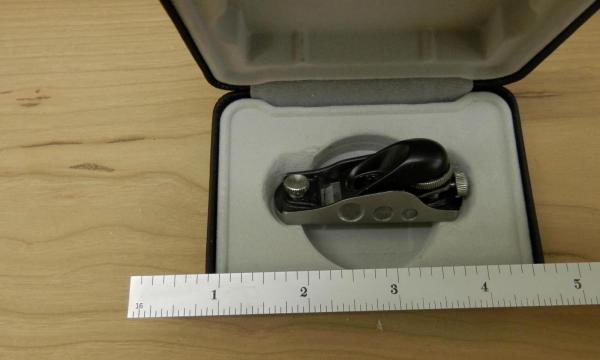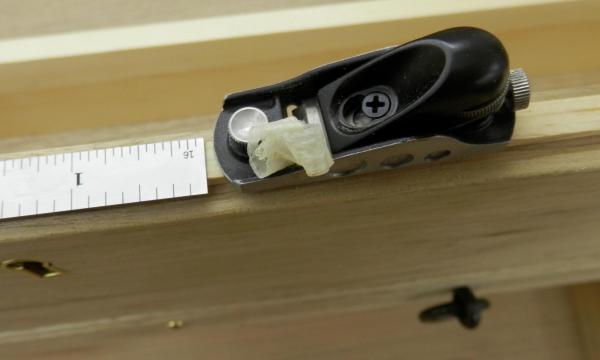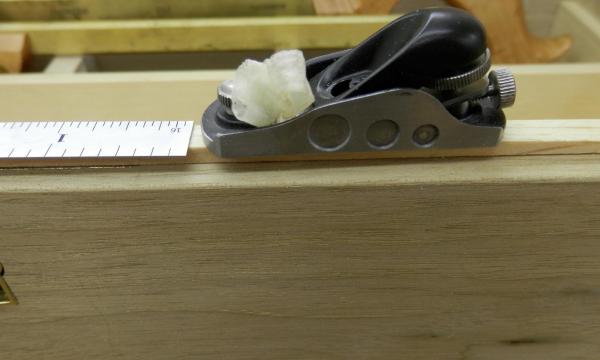-
Posts
38 -
Joined
-
Last visited
Content Type
Profiles
Forums
Gallery
Events
Everything posted by NHDave
-
It's used as chafing protection for sails that may come in contact with a section of rigging line. If it can be well done it is a nice addition, but I would omit unless it can be reproduced realistically in the scale you are working. I'm not sure how far back it's use goes, but it is still used today. Dave
-

Grand Banks Dory color
NHDave replied to jbelwood's topic in Painting, finishing and weathering products and techniques
Many years ago when I was a commercial fisherman, the traditional New England trawlers all had one or two dories carried on the top of the wheelhouse. These were almost all painted a buff color. Can't say why buff, but these trawlers were a direct descendent to the schooners you refer to. Dave -

Can i live without a BYRNES TABLE SAW
NHDave replied to shihawk's topic in Modeling tools and Workshop Equipment
Like any hobby, you don't need to start with every hand tool. To flatten the board by hand, you could start with a #5 Stanley with a couple of additional blades. There were thousands of those planes made and can be picked up very reasonably. Dave -

Can i live without a BYRNES TABLE SAW
NHDave replied to shihawk's topic in Modeling tools and Workshop Equipment
A well fettled and well sharpened hand plane will true the surface of stock (especially the size being managed to produce model size timber) as well (actually better in many instances) than a jointer. One thing to avoid, for safety's sake, with a full size jointer, planer, or table saw is trying to mill small pieces. The other caution with power tools. One small slip or bobble can destroy a lot of valuable wood. I own several power routers but actually prefer hand tools for final work to avoid just that scenario. Dave -
I recall years ago reading about heating the plates in a cast iron skillet and that the plates would darken and color. You might try that with a few test plates. Dave
- 9 replies
-
- Charles Morgan
- copper plating
-
(and 1 more)
Tagged with:
-
Just thought I'd mention this little low angle block plane from Lee Valley. The shavings are about 1/2 a thou. Dave
-
dgbot, Check out the Norton water stones. They are very good quality and not as expensive as the Japanese ones. They make them in combination stones also. Just remember to flatten them often (like every use) as water stones are soft (hence why they cut so fast). You can use your sandpaper and glass/stone base for that. Dave
-
I am old fashioned too, and prefer books to Kindal etc. However, the content to be found here is so much more comprehensive. You can spend hours checking out the content here. Nothing more dissapointing than to wait a month or more for a magazine to arrive only to find one or two relevent arcticles. Just my opinion. Dave
-
I can't help but compare the lines of Young America's stern to that of a modern ship. One gets the feeling that a fold in the plans was reached in the latter, and the stern was terminated right then and there with no further ceremony. Dave
- 3,596 replies
-
- young america
- clipper
-
(and 1 more)
Tagged with:
-
Opening a discussion on sharpening is akin to bringing up politics or religion. Having said that, I agree with Grimber. I like to use a 1000 grit diamond stone, an 8000 or 16000 grit water stone to finish, and a grinding wheel to reset the bevel when needed. Dave
-
Todd, Check out Ed's build log of the clipper Young America http://modelshipworld.com/index.php/topic/3453-young-america-by-edt-extreme-clipper-1853/. It's not a kit but a scratch build, but lots of good info on a vessel of the period you're interested in. Dave
-
Lee Nielsen makes a "model maker's" plane modeled after the Stanley 100. I use an original Stanley 100, but have several Lee Nielsen planes. I have never regretted spending the money on a quality tool. There are quite a few older (antique?) tools out there that can be brought back to first class condition if the new one breaks the bank. A tool functions in proportion to its price. Buy cheap and you will never be happy with the results. Just my opinion. Dave
-

Were ship figureheads routinely removed?
NHDave replied to robnbill's topic in Nautical/Naval History
I too have read of this on Cape Hornners. -
Glad to hear your position on the rigging. My thoughts exactly. With your level of skill, I can only imagine what's to come. Dave
- 3,596 replies
-
- young america
- clipper
-
(and 1 more)
Tagged with:
-
I am using Win8 and had to switch to Chrome from IE just to get on this site when I joined. Dave
- 3,596 replies
-
- young america
- clipper
-
(and 1 more)
Tagged with:
-
Just thought I'd give a final update on my correspondence with Model Shipbuilding Secrets. I finally received a reply today in answer to my Oct 18 email to their customer support address. I was offered a refund due to the viewing issues, but declined as I have been able to access the contents thanks to Hornet. Dave
-
Finally caught up to date after recently discovering your build log, and I must say, your skill is most impressive. I would also like to extend my thanks to you for generously sharing your expertise. A very good source for the era of the medium clippers is BASIL lubbock's THE DOWN EASTERS. Frequent mention is made of crews being gathered up by the crimps and the bucko mates and hard case captains well into the end of the 19th century. And of course the big down easters continued to be built entirely of wood into the early 20th century. He also lists many impressive passages by these ships. Once again, thanks, and I'll be following your progress. Dave
- 3,596 replies
-
- young america
- clipper
-
(and 1 more)
Tagged with:
-
Like robnbill I also have a woodworking shop. A Sawstop is next on my list. It is an exceptionally well made saw and cost about the same as a comparable cabinet saw. Contrary to popular belief, the saw does not have to be rebuilt if the cartridge is activated. One other point to remember is to avoid ripping short pieces. I do my jointing, planing, and ripping before crosscutting to length. As several other members said...trust your gut. If you feel uneasy about a proceedure, find an alternative method. Dave
-
Sorry, forgot the link. http://store.whalingmuseum.org/products/charles-w-morgan
-
Jo V. There are 3 sheets, 1 sheet with lines, sheer, deck, 1 sheet of complete sail plan, and 1 sheet with large scale mast and yard drawings. All for $10 plus shipping. Just go on the New Bedford Whaling Museum web site. Go to the online store. They ship very quickly. Dave
-
Just thought I'd post this to get some feedback from any of the CWM modelers that may have experience with this. While beginning the construction of the model I decided to order the set of plans from the Dartmouth Historical Society. I had seen through the New Bedford Whaling Museum site that the plans included a complete set of lines that the MSW plans don't include. I was debating adding extra bulkheads to the build and wanted the lines to loft from. I was pleased to find the plans were the same scale as the MSW plans, but as I examined them I found the hull on the DHS plans to be 1 1/16" longer along the keel than the MSW plan. The MSW booklet describes the ship as 106 ft. 6in. and the DHS plans indicate a length of 105 ft. 7 in. The latter were drawn in 1977 while the MSW plans were 1997. I realize the measurments may vary as to what parameters were used, but at the same scale I would not expect to find an almost 6 ft. length difference. I have seen some very impressive builds of this kit here, so I'm sure it's not an issue if the kit plans are followed, but was puzzled all the same. By the way, the plans from the DHS include an extremely detailed set of drawings of the mast and yard fittings. Dave
-
OK, I'll chime in one more time; Here are the "chapters" on the disk: The Plans, Internal Construction, Hull Construction, Keel Joint, Deck Beams, Gun Ports, Deck Nails, Deck Caulking, Top Deck Construction, Top Deck Planking, Top Deck Varnishing, and Beveling. Granted, some of these chapters or subjects are fairly brief, but total play time is about 3hr 18 min. My disk played thru Gun Ports (about half way through) and acted as if there was no material recorded in the remaining chapters, even though they were listed in the intro. After following Hornet's suggestion, I have been able to view the remainder of the disc. When copied to a folder on my HD, the files were exactly as described by Hornet, and my video player has had no trouble playing the disk. Thanks again Hornet. Dave
About us
Modelshipworld - Advancing Ship Modeling through Research
SSL Secured
Your security is important for us so this Website is SSL-Secured
NRG Mailing Address
Nautical Research Guild
237 South Lincoln Street
Westmont IL, 60559-1917
Model Ship World ® and the MSW logo are Registered Trademarks, and belong to the Nautical Research Guild (United States Patent and Trademark Office: No. 6,929,264 & No. 6,929,274, registered Dec. 20, 2022)
Helpful Links
About the NRG
If you enjoy building ship models that are historically accurate as well as beautiful, then The Nautical Research Guild (NRG) is just right for you.
The Guild is a non-profit educational organization whose mission is to “Advance Ship Modeling Through Research”. We provide support to our members in their efforts to raise the quality of their model ships.
The Nautical Research Guild has published our world-renowned quarterly magazine, The Nautical Research Journal, since 1955. The pages of the Journal are full of articles by accomplished ship modelers who show you how they create those exquisite details on their models, and by maritime historians who show you the correct details to build. The Journal is available in both print and digital editions. Go to the NRG web site (www.thenrg.org) to download a complimentary digital copy of the Journal. The NRG also publishes plan sets, books and compilations of back issues of the Journal and the former Ships in Scale and Model Ship Builder magazines.





